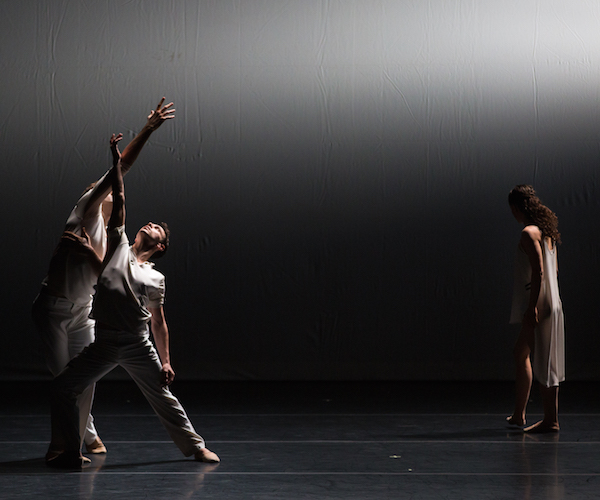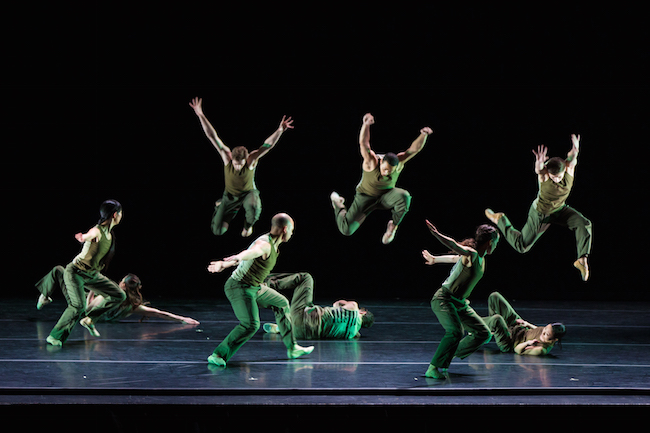Dance Review: Jessica Lang Dance — Flowing with the Go
I like to see dances that are somehow all of a piece. Hope this doesn’t mean I’m sinking into some kind of retro-fogeyism.
Jessica Lang Dance, presented by Celebrity Series at the Boch Center Shubert Theater, Boston, MA, on January 27 and 28.

A moment in the Jessica Lang Dance performance of “Sweet Silent Thought.” Photo: Robert Torres.
By Marcia B. Siegel
Friday’s mixed program of dances by Jessica Lang seemed to scrape away the frills from reams of “contemporary” choreography we’ve seen lately. Lang’s six short pieces felt calm and light even when they were fast or dark. There was no violence, only the nine barefoot dancers moving through surprisingly specific spaces.
Lang, like the two predecessors to whom she’s often compared, Paul Taylor and Mark Morris, respects music for its structure as well as its mood. With a flair for visual effects created by dancing, Lang trusts the audience to see how dancing itself is musical and to get dancing jokes and relationships. She doesn’t over-choreograph just for the sake of thrilling the audience. I guess I’m describing how a modern dancer works, and even if that’s outdated, I prefer it to scads of invented but meaningless movement.
Friday’s program opened with Solo Bach (2008) to a gavotte from the Third Partita, recorded by violinist Lara St. John. Dancer Patrick Coker reminded me of the welcoming woman, originated by Lila York in Paul Taylor’s Esplanade, as he opened his arms to the audience and moved lightly, elastically around the stage, his fluttering hands stirred by the music’s ornaments. Later in the evening, Julie Fiorenza performed The Calling, an excerpt from a 2006 dance, to an early-music plainchant sung by the Norwegian Trio Mediaeval. Like the music, this dance was very spare, creating a visual analog to the alto melody with its underlying bass line. Fiorenza stood surrounded (entrapped?) by a white gown whose skirt covered nearly half the stage. You’d think such a dance would be static, given the limitations of the costume (by Elena Comendador, suggested by Lang). Instead, Fiorenza twisted and gestured smoothly but not mechanically, rising and sinking into the skirt as it wrapped around her body.
Another phase of Lang’s busy career—she choreographs for ballet companies as well as her own—was shown in two pieces made during a creative residency at the Joyce Theater in New York in 2011. White: A Dance on Film exploited the technical virtuosity of video. Six dancers, you don’t see them all at once, move in and out of the frame. At first they look pixilated, like broken TV images. Later, the camera can be manipulated to slow them down so they seem to be flying when they jump, or speed them up to a recording of an Edvard Grieg piano piece played at hyper tempo. The screen figures dwarf dancers in the flesh, but the lens can enable other distorted effects: the nearest dancers look bigger than those in the background. Watching the evolution of these digital creatures turned out to be more interesting than trying to imagine them in a real dance.
Things segued immediately into another screen piece, i.n.k. There were no humans in the film, only mysterious objects that the seven real dancers could have been trying to ignore. Contrasting with the white screen and costumes of the previous piece, the dancers wore black. On the big universe above them, specks began flying across as if blown by a wind. The specks became ominous blobs of ink, or blood, then pools, with blobs dropping into them, then a great black smothering spill. When big spots stacked up along the side of the screen, the dancers bounced up and down and the spots rebounded like beach balls.
The dancers had games of their own to play. To a watery digital score by Jakub Ciupinski that seemed to come out of the screen-play (KUSHO by Shinichi Maruyama), they ran on all-fours, did shoulder stands and slow walkovers, and seemed, unknowingly, to be playing with the digital designs.
Clifton Brown and Kana Kimura danced a slow, precise duet. He anchored her as she echoed his moves, pulled away, started to keel over. When they parted, their bodies curved inward, like the halves of a circle, and their arms scooped together to close the loop. A drop of water inched down the screen and fell into the floor with a slow splash. The blobs thinned out and the dancers played their last games. Kimura, who had started the dance as a kind of insect making her way across the bottom of the screen, was the last one left. With a curved arm and hand, Brown pulled her off.

A moment in the Jessica Lang Dance performance of “Thousand Yard Stare.” Photo: Robert Torres.
Thousand Yard Stare (2015) begins with the most minimal movement. Minimal, as opposed to simple. Seven of the nine dancers in army fatigues are lined up along one side while two others lean forward and step toward them with a one/one-two-three/hold rhythm. Gradually they all enter the space and the rhythm. They spread out and so does the step-pattern until they form into unisons and spacious counterpoint. With understated goofiness they line up spoon fashion, on all fours, and one at a time they scootch through the line of legs. There’s lifting and falling and strobe lights. Then they fall back into the stepping pattern they started with.
Lang’s most recent dance on the program, Sweet Silent Thought (2016), might have been related to the quartet on the White film. Four dancers in white are immersed in a scratchy recording of half-intelligible voices reciting something that could be Shakespeare. I only caught parts of the language, but I could tell that it is made up of phrases and rhymes. After a while the scratches collect into a definite rhythm that takes over. (The score is by Ciupinski.) The two women and two men cluster together and move into new designs, changing partners, sometimes in twos, or in collective lifts of three or four. I can’t tell who wants whom.
What I liked so much about this performance was that each piece was different from the others, yet they all hung together on the strength of Lang’s imagination. The dancers served the ideas with beautiful discipline and control. Their movement seemed almost ordinary, often stemming from walking and basic turning. This is the origin of much of Morris’s and Taylor’s dance too, though in different ways all of their work has evolved beyond the pedestrian. I like to see dances that are somehow all of a piece. Hope this doesn’t mean I’m sinking into some kind of retro-fogeyism.
Internationally known writer, lecturer, and teacher Marcia B. Siegel covered dance for 16 years at The Boston Phoenix. She is a contributing editor for The Hudson Review. The fourth collection of Siegel’s reviews and essays, Mirrors and Scrims—The Life and Afterlife of Ballet, won the 2010 Selma Jeanne Cohen prize from the American Society for Aesthetics. Her other books include studies of Twyla Tharp, Doris Humphrey, and American choreography. From 1983 to 1996, Siegel was a member of the resident faculty of the Department of Performance Studies, Tisch School of the Arts, New York University.
